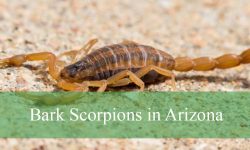Arizona is home to one of the greatest concentrations of venomous snakes in the United States, thanks to its varied terrain and desert climate. From dry lowland basins to rugged mountain slopes, the state offers prime habitat for many species. Rattlesnakes are the most prominent, and Arizona holds the distinction of having more rattlesnake species than any other state.
This article highlights 13 venomous snakes in Arizona, featuring both widespread species like the Western Diamondback and Mojave Rattlesnake, as well as rare and localized ones such as the Arizona Ridge-nosed Rattlesnake and the Sonoran Coral Snake. Each profile includes detailed information on identification, habitat, venom type, and where these snakes are commonly found.
Recognizing venomous snakes in Arizona is important for staying safe while enjoying the outdoors. With proper knowledge and awareness, it becomes easier to avoid dangerous encounters and appreciate the important role these reptiles play in controlling pest populations and maintaining ecological balance.
Common Venomous Snakes in Arizona
Western Diamondback Rattlesnake (Crotalus atrox)
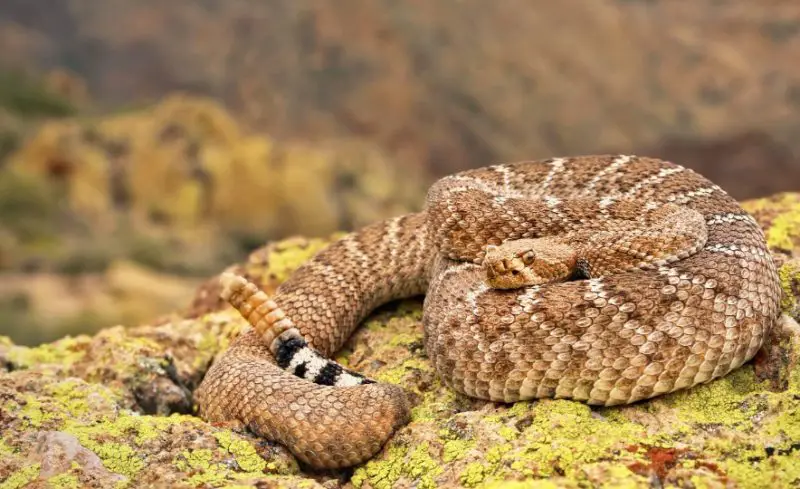
The Western Diamondback Rattlesnake is the most commonly encountered rattlesnake in Arizona and one of the largest venomous snakes in North America. Adults typically measure between 3 to 5 feet in length, though individuals over 6 feet have been recorded. It has a heavy body with a triangular-shaped head, and its coloration varies from gray to brownish tones, with a series of dark diamond-shaped blotches running down its back. The tail is banded in black and white, which gives it a “coontail” appearance.
This species is easily identified by its distinctive diamond pattern and the loud, buzzing rattle on its tail, which it uses as a warning when threatened. The head is broad and covered in keeled scales, and the eyes have vertical pupils typical of pit vipers. Like other rattlesnakes, it has heat-sensing pits between its eyes and nostrils, which help it locate warm-blooded prey. Its camouflage helps it blend well into desert and scrub environments.
The venom of the Western Diamondback is primarily hemotoxic, which means it affects blood cells and tissues. Bites can cause severe pain, swelling, tissue destruction, and in rare cases, can be fatal if not treated promptly. This species is defensive rather than aggressive and typically strikes only if provoked or surprised. It will usually give a clear warning rattle before attacking.
In Arizona, the Western Diamondback Rattlesnake is found throughout the state, from desert lowlands to grassy plains and even into wooded foothills. It thrives in a wide range of habitats including Sonoran and Chihuahuan deserts, rocky hillsides, canyons, and areas with brush or mesquite. It is often seen basking on roads or trails, especially during the spring and fall when temperatures are mild.
Mojave Rattlesnake (Crotalus scutulatus)
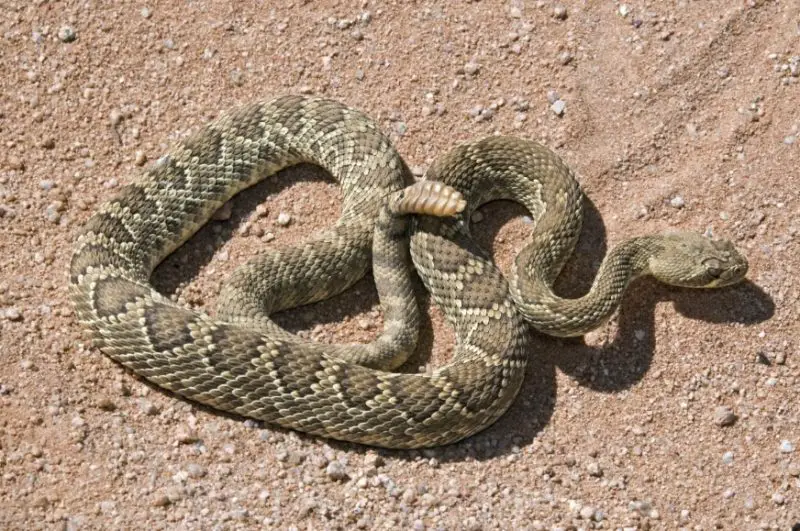
The Mojave Rattlesnake is a medium to large-sized pit viper known for its potent venom and its resemblance to the Western Diamondback. It typically grows to lengths between 2.5 to 4.5 feet. Its overall coloration ranges from greenish-gray to brown or even dusty tan, depending on the local environment. A series of diamond-like dorsal blotches adorn its back, and its tail also features light and dark bands, although the light bands are usually wider than the dark ones—one way to differentiate it from the Western Diamondback.
This species can be identified by its relatively slim body, large head, and the unique color of its scales. Another distinguishing feature is the shape and spacing of its tail bands. Additionally, Mojave Rattlesnakes tend to have more prominent scales between the eyes compared to their close relatives. Despite the similarity in appearance to other rattlers, experienced herpetologists often rely on geographic location and subtle traits for proper identification.
The venom of the Mojave Rattlesnake is considered among the most toxic of all North American snakes. It contains both hemotoxic and neurotoxic components, with the latter capable of affecting the nervous system. Neurotoxins can cause paralysis, difficulty breathing, and even respiratory failure in severe cases. Though antivenin is available, medical attention must be sought immediately following a bite due to the venom’s rapid and potentially life-threatening effects.
In Arizona, the Mojave Rattlesnake is commonly found in the southern and western parts of the state. Its preferred habitats include desert flats, scrublands, grasslands, and open woodlands, especially areas with sparse vegetation. It is most active in warm weather, often seen during the early morning or late afternoon hours in spring and summer. During the cooler months, it typically shelters in rodent burrows or under rocks.
Arizona Black Rattlesnake (Crotalus cerberus)

The Arizona Black Rattlesnake is a medium-sized, secretive pit viper primarily found in mountainous regions of central and eastern Arizona. Adults usually range from 2.5 to 4 feet in length. Its body is stout, and its coloration can vary significantly—from dark brown to nearly black—depending on elevation, habitat, and even the season. Juveniles have more defined patterns that fade with age. Interestingly, this species can change color slightly from darker in cool conditions to lighter tones in warmer environments, a trait uncommon among rattlesnakes.
Identification of the Arizona Black Rattlesnake can be challenging due to its variable appearance. However, most individuals have a dark base color with faded crossbands or blotches and a relatively short, thick tail ending in a typical rattle. The head is broad and covered with keeled scales, and like other pit vipers, it has heat-sensing facial pits. This snake’s darker coloration helps it remain camouflaged in shadowy forest floors and rocky slopes.
Its venom is primarily hemotoxic, causing swelling, pain, and tissue damage around the bite site. While not considered as dangerous as the Mojave’s venom, a bite from this snake still requires immediate medical attention. The species is generally non-aggressive and prefers to avoid confrontation. It relies heavily on its camouflage and will remain motionless if approached, rattling only when it feels cornered or threatened.
In Arizona, the Arizona Black Rattlesnake is typically found at elevations ranging from 4,000 to 8,000 feet. It inhabits oak woodlands, pine forests, rocky hillsides, and canyon streams in the Mogollon Rim and White Mountains. It is diurnal during spring and fall and may become more nocturnal during the heat of summer. Because of its secretive nature, it is rarely seen by casual hikers, although it is relatively common within its range.
Tiger Rattlesnake (Crotalus tigris)
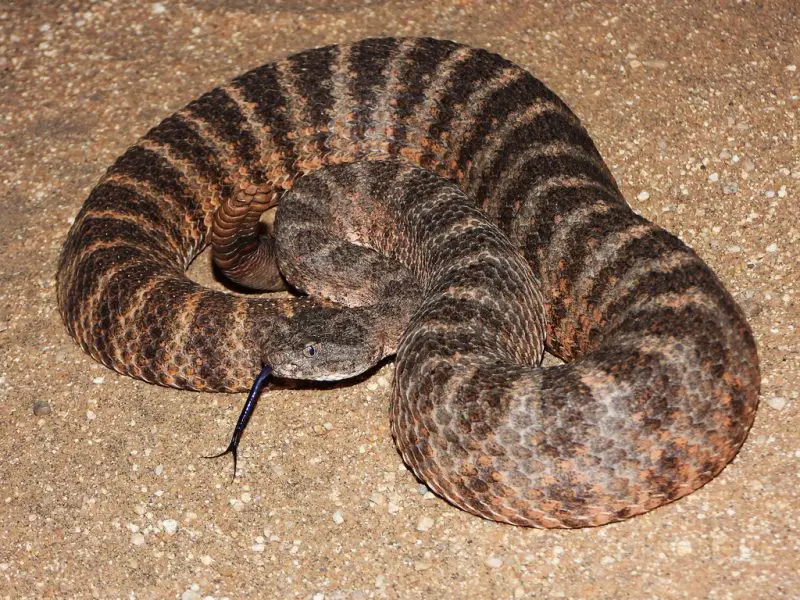
The Tiger Rattlesnake is a small but highly venomous rattlesnake native to southern Arizona. Adults usually measure between 18 to 36 inches in length, making it one of the smallest rattlesnake species in the state. It has a relatively small head in proportion to its body and a slender neck, which can make it appear fragile or unassuming. Despite its size, it possesses a potent venom that ranks among the most toxic of all rattlesnakes.
This species gets its name from the dark, vertical striping along its light gray or pinkish body, giving it a tiger-like appearance. The pattern becomes more distinct toward the tail. It has a relatively short rattle and keeled scales that give it a rough texture. The head is blunt, and the eyes are small with vertical pupils. These unique characteristics make it fairly easy to identify if seen clearly.
The venom of the Tiger Rattlesnake is a powerful mix of neurotoxins and myotoxins, capable of causing severe damage to muscles and the nervous system. Despite the strength of its venom, the snake is generally shy and reclusive. It tends to avoid humans and will only strike if provoked or unable to flee. Because of its remote habitat and elusive behavior, bites are extremely rare.
In Arizona, the Tiger Rattlesnake is found primarily in the Sonoran Desert and rocky foothills of southern counties such as Pima, Santa Cruz, and Cochise. It prefers steep, rocky slopes with sparse vegetation, often hiding under rocks or in crevices during the heat of the day. It is most active during the evening and night in the warmer months, making it a challenge to observe in the wild.
Sidewinder Rattlesnake (Crotalus cerastes)
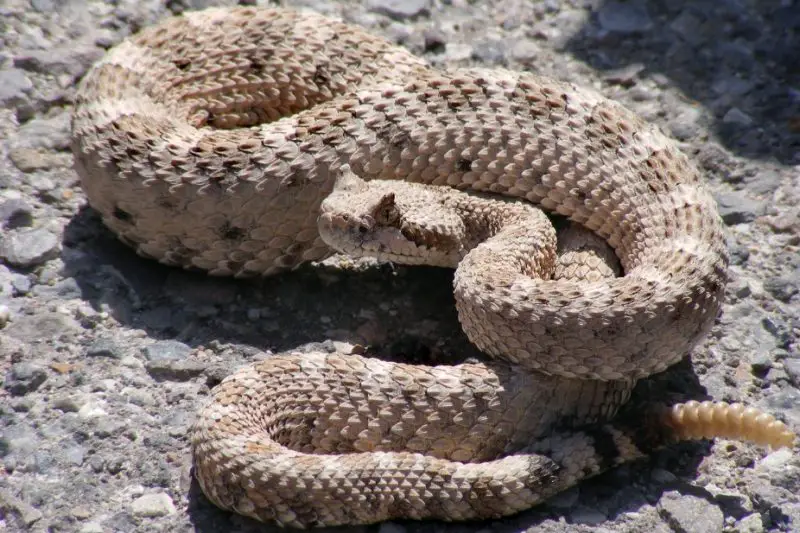
The Sidewinder Rattlesnake is one of the most distinctive snakes in Arizona due to its unique method of movement and its desert-adapted appearance. Adults typically measure between 18 to 30 inches in length and are relatively small compared to other rattlesnakes. It is well known for its sideways slithering motion, which helps it efficiently travel across hot, loose sand without sinking. This movement leaves characteristic J-shaped tracks on the ground.
The Sidewinder is recognized by the horn-like scales above each eye, which may help shade the eyes from the desert sun or assist with burrowing. Its coloration ranges from pale beige to light gray or pink, often with darker blotches along the back that blend seamlessly into the sandy environment. These camouflage adaptations make it nearly invisible in its natural habitat until it moves or rattles.
The venom of the Sidewinder is primarily hemotoxic, causing pain, swelling, and tissue damage. Although its venom is not considered as potent as some other rattlesnakes, its bite can still be dangerous and requires medical treatment. This species tends to be less aggressive and will often bury itself in the sand, leaving only its eyes and horns exposed while waiting to ambush prey such as lizards or rodents.
In Arizona, the Sidewinder is found in the southwestern deserts, particularly in areas with sandy soils like the Yuma Desert and parts of the Sonoran Desert. It prefers dry washes, dunes, and open creosote bush flats. This snake is primarily nocturnal during the hot summer months but may be active during the day in cooler seasons. Its cryptic nature makes it more often heard than seen, with its rattle providing the main warning of its presence.
Black-tailed Rattlesnake (Crotalus molossus)

The Black-tailed Rattlesnake is a medium to large-sized species known for its calm demeanor and distinctive appearance. Adults typically range from 3 to 4 feet in length, though some may exceed 5 feet. Its body is robust, with a well-defined black tail that sharply contrasts with the rest of its yellowish, olive, or brownish body, which is usually covered in irregular dark blotches.
This species is easily recognized by the solid black coloration on its tail, just before the rattle, and the two black diagonal facial stripes running from the eyes to the corners of the mouth. Its scales are strongly keeled, and the head is broad and triangular. Its camouflage allows it to blend into rocky and forested environments, making it difficult to spot unless it moves or rattles.
The venom of the Black-tailed Rattlesnake is hemotoxic and can cause swelling, pain, and tissue damage, though it is generally less dangerous than that of the Mojave or Tiger Rattlesnake. This snake is known for being relatively docile and may give ample warning before striking. It relies on ambush hunting, feeding on small mammals, birds, and reptiles, and often returns to the same den sites each winter.
In Arizona, the Black-tailed Rattlesnake is most commonly found in central and southern parts of the state, including areas like the Chiricahua Mountains, Santa Catalina Mountains, and Tonto National Forest. It inhabits rocky hillsides, canyon slopes, oak woodlands, and pine forests, ranging from 3,000 to 9,000 feet in elevation. During the cooler months, it retreats to rocky crevices and may brumate communally with other snakes.
Speckled Rattlesnake (Crotalus mitchellii)
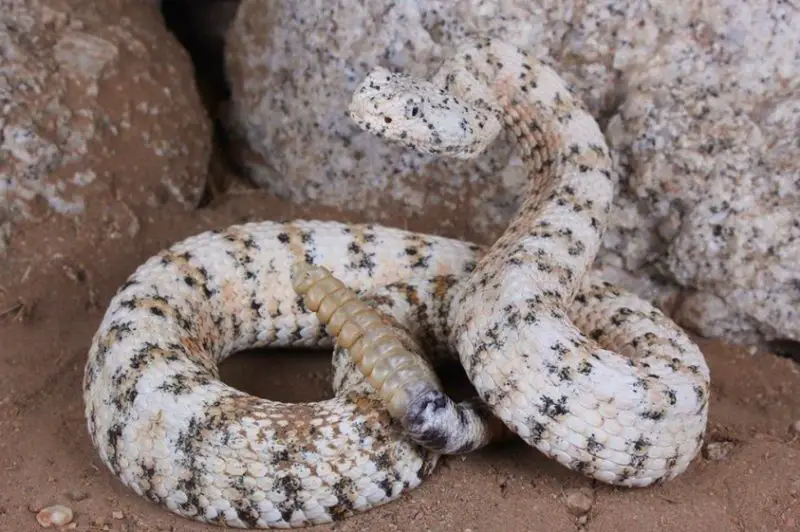
The Speckled Rattlesnake is a highly adaptable and visually variable rattlesnake that blends into its surroundings better than most. It usually measures between 2 to 3 feet in length, though some individuals can grow larger. The coloration and patterning of this species are extremely diverse, varying by locality to match the dominant color of surrounding rocks—ranging from pale gray to tan, pink, or even lavender.
This species gets its name from the fine speckled pattern covering its body, which breaks up its outline against rocky terrain. Its head is large and distinct from the neck, and it has a relatively short tail with a muted rattle. This snake is more secretive than many other rattlers and is often motionless or hidden under rocks during the heat of the day, making it difficult to observe in the wild.
The venom of the Speckled Rattlesnake is primarily hemotoxic, though the potency can vary depending on the region. It causes swelling, pain, and tissue damage, but fatalities are rare with prompt medical treatment. The species is an ambush predator, lying in wait for lizards, small mammals, and birds. It tends to be shy and secretive, usually choosing to flee or remain hidden rather than confront threats.
In Arizona, the Speckled Rattlesnake is found primarily in the western and southern parts of the state. It inhabits desert mountain ranges, boulder-strewn hills, and rocky canyons, such as those found in the Kofa Mountains, Tucson Mountains, and Superstition Wilderness. It is primarily nocturnal during the warmer months and may be active in the early morning or late afternoon in spring and fall.
Grand Canyon Rattlesnake (Crotalus oreganus abyssus)
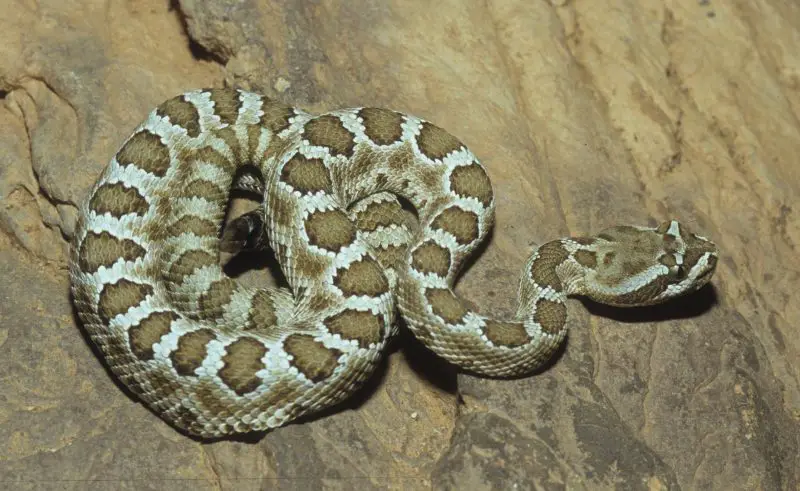
The Grand Canyon Rattlesnake is a visually striking subspecies of the Western Rattlesnake, found almost exclusively within the Grand Canyon region. It typically grows to a length of 2.5 to 3.5 feet and is known for its unusual pinkish or reddish coloration, which closely matches the hues of the Grand Canyon’s rock layers. This cryptic coloring provides excellent camouflage against the canyon walls and floor.
Identifying the Grand Canyon Rattlesnake involves noting its soft reddish or rose-colored scales, which set it apart from other rattlesnakes in Arizona. Like other members of the Western Rattlesnake complex, it has a large triangular head, a narrow neck, and distinct blotches or crossbands along its back. Its tail usually has several dark rings near the rattle. The species also has facial heat-sensing pits and keeled scales.
The venom of this rattlesnake is moderately potent and primarily hemotoxic, causing pain, swelling, and local tissue effects. Though it is venomous, the Grand Canyon Rattlesnake is not considered overly aggressive. It will usually remain still or attempt to escape when encountered and gives a warning rattle before striking. Like many other rattlesnakes, it feeds on rodents, lizards, and small birds.
In Arizona, this subspecies is found almost exclusively within the Grand Canyon and surrounding areas, including both the north and south rims, as well as canyon trails and side canyons. It prefers rocky ledges, talus slopes, and scrubby areas within the canyon. Due to its limited range and well-camouflaged appearance, sightings are rare and usually occur along trails used by hikers and backpackers exploring the national park.
Twin-Spotted Rattlesnake (Crotalus pricei)

The Twin-Spotted Rattlesnake is a small, rare species that inhabits high-elevation mountain ranges in southeastern Arizona. Adults typically reach lengths of only 18 to 24 inches, making it one of the smallest rattlesnakes in the state. Its body is relatively slender with a short tail and small rattle. This snake gets its name from the two parallel rows of dark spots that run along its back, set against a background that can range from gray to pinkish hues.
It is easily identified by its compact size, the paired dorsal spots, and its rough, keeled scales. The head is relatively small and blends well with the rest of the body, and its coloration is often finely tuned to the lichen-covered rocks and leaf litter of its montane habitat. Despite its cryptic pattern, the twin rows of spots are a reliable field mark for those lucky enough to see it.
The venom of the Twin-Spotted Rattlesnake is primarily hemotoxic and not considered highly dangerous to humans due to the snake’s small size and relatively mild venom. Bites are extremely rare because the snake is shy and reclusive, spending much of its time under rocks or in crevices. It feeds on small lizards, amphibians, and occasionally rodents, using ambush tactics.
In Arizona, this rattlesnake is found in the “sky islands” of southeastern Arizona, especially in the Huachuca, Chiricahua, and Santa Rita Mountains, at elevations typically above 6,000 feet. It inhabits rocky talus slopes, pine-oak forests, and cool canyon floors. Because of its limited range and secretive nature, it is seldom encountered by hikers and herpetologists alike.
Arizona Ridge-nosed Rattlesnake (Crotalus willardi willardi)
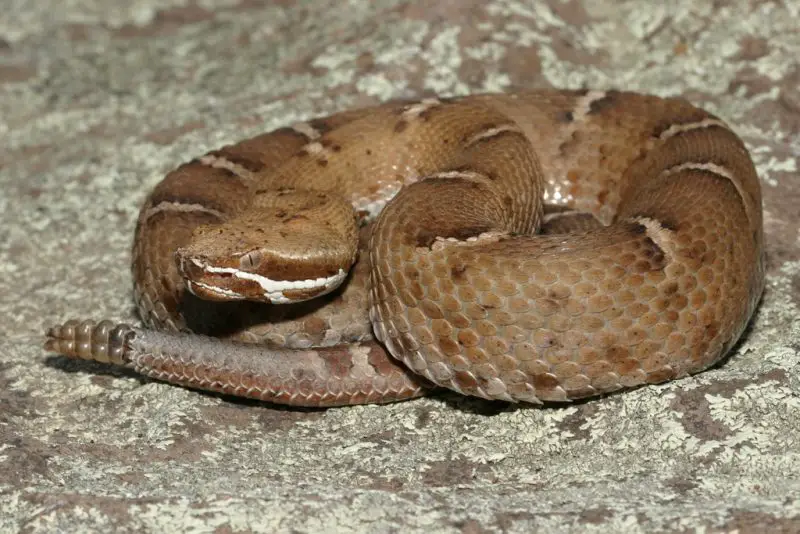
The Arizona Ridge-nosed Rattlesnake is a small and elusive species that holds the distinction of being Arizona’s official state reptile. Adults rarely exceed 24 inches in length, with slender bodies and short tails. This snake is named for the series of raised ridges on its nose, which are unique among rattlesnakes. Its body is reddish-brown or cinnamon-colored, with subtle darker bands and a striking white or cream-colored stripe extending from the nose to behind the eyes.
This species is one of the most visually distinct rattlesnakes in the region, due in part to the pale facial stripe and the slightly upturned ridge on the snout. Its camouflage blends beautifully with the leaf litter and rocky ground of its forested mountain habitat. Despite being venomous, it is extremely reclusive and rarely poses any danger to humans.
The venom of the Arizona Ridge-nosed Rattlesnake is hemotoxic but relatively mild. Its small size and shy temperament further reduce the risk of envenomation. It typically feeds on lizards, frogs, and small mammals, and it hunts by lying in wait among rocks or under logs. It may rattle softly when disturbed, but often remains still and hidden.
This snake is endemic to the sky island mountain ranges of southeastern Arizona, including the Huachuca, Santa Rita, and Patagonia Mountains, usually at elevations between 5,000 and 8,000 feet. It prefers shaded canyons, pine-oak woodlands, and moist ravines. Due to its limited range, it is listed as a threatened species and is protected under Arizona law.
Rock Rattlesnake (Crotalus lepidus)
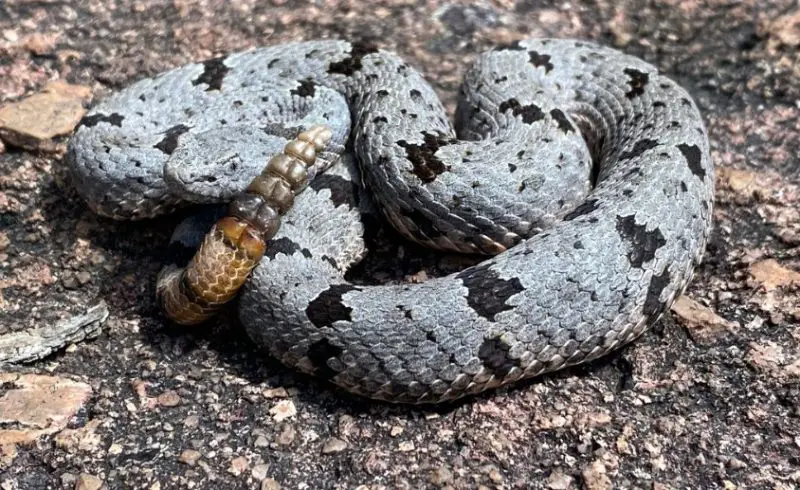
The Rock Rattlesnake is a small to medium-sized species known for its incredible camouflage and adaptability to rocky environments. Adults usually measure between 18 to 32 inches in length. Its coloration varies widely depending on the geological makeup of the surrounding rocks, ranging from light gray or tan to greenish or bluish tones with dark crossbands. This perfect camouflage makes it one of the most difficult rattlesnakes to spot in the wild.
Its head is broad and triangular with a relatively short, blunt snout. The eyes are medium-sized with vertical pupils, and its body is covered in strongly keeled scales. Rock Rattlesnakes are generally sedentary and rely on remaining motionless to avoid detection. The banded pattern on their bodies may be broken or complete, depending on the individual and its locality.
The venom of this species is hemotoxic and generally not considered life-threatening, though it can still cause significant local effects like pain and swelling. Because of its calm nature and tendency to remain still, bites are rare. The Rock Rattlesnake feeds on lizards, rodents, and small birds, often ambushing prey from rock crevices.
In Arizona, it is found in the southeastern mountain ranges, such as the Chiricahua, Huachuca, and Mule Mountains. It prefers rocky hillsides, talus slopes, and dry canyons typically above 4,000 feet in elevation. Due to its excellent camouflage and secretive behavior, it is most often encountered by experienced herpetologists or very observant hikers.
Prairie Rattlesnake (Crotalus viridis)
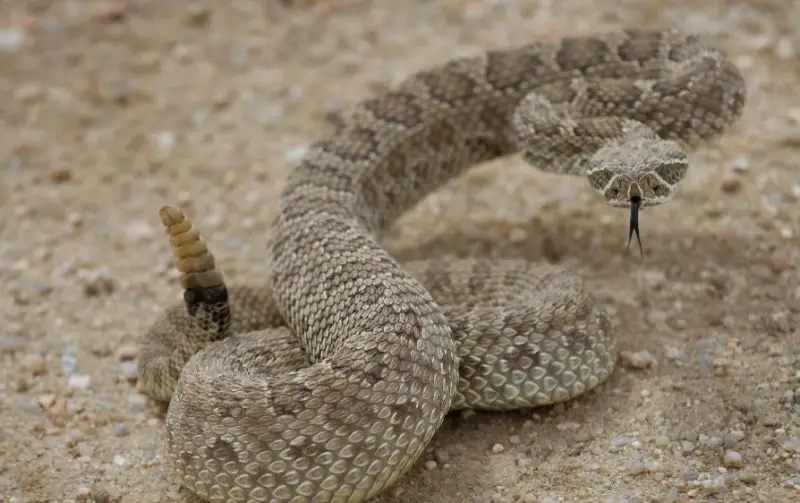
The Prairie Rattlesnake is a widespread and adaptable species found in the northern and northeastern parts of Arizona. Adults range from 3 to 5 feet in length and are characterized by a relatively slender build and light tan to greenish body color, marked by dark blotches along the back that transition into crossbands near the tail. The tail ends in a relatively long rattle, often raised in a defensive posture.
This species can be identified by its broad head, prominent eyes, and pattern of dark dorsal blotches. A pair of light lines often runs diagonally from behind the eyes toward the corners of the mouth. The Prairie Rattlesnake is quick to defend itself and may hiss or rattle when approached. It is more prone to stand its ground than some of its more reclusive relatives.
The venom of the Prairie Rattlesnake is primarily hemotoxic but may also contain some neurotoxic elements, depending on the region. A bite can result in significant pain, swelling, and tissue damage, though fatalities are rare with medical treatment. It hunts by ambush and preys on small mammals, birds, and reptiles. This species is an important predator in the grassland ecosystem.
In Arizona, the Prairie Rattlesnake is found mainly in the northeastern grasslands and semi-arid plateaus, including parts of the Colorado Plateau, Coconino County, and areas near the Four Corners. It favors open areas such as prairies, shrublands, and rocky outcrops, and may be active during the day or night depending on the season. It is one of the more frequently encountered rattlesnakes in Arizona’s northern range.
Sonoran Coral Snake (Micruroides euryxanthus)
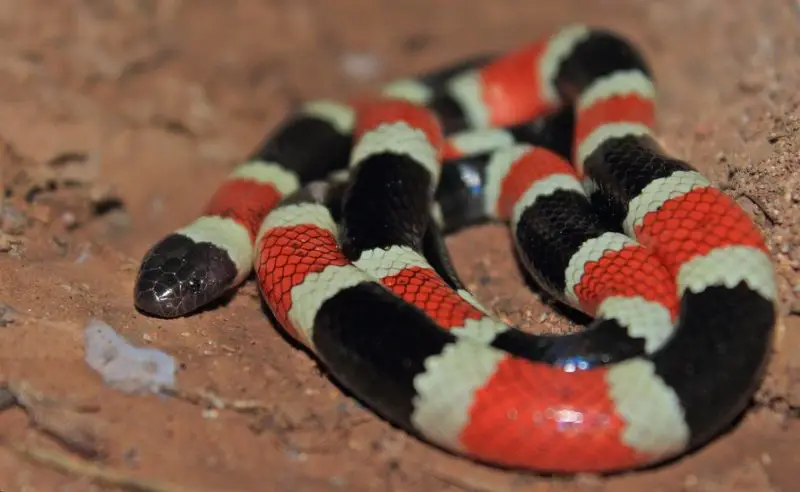
The Sonoran Coral Snake is a small, elusive, and vividly colored venomous snake native to southern Arizona. Adults typically measure between 11 and 24 inches in length and have a slender body. Its striking pattern consists of alternating red, yellow (or white), and black rings, with red bands touching yellow bands—a key identifier expressed in the well-known rhyme: “Red on yellow, kill a fellow; red on black, friend of Jack.”
This snake is easily confused with harmless mimics such as the Shovel-nosed Snake or Kingsnake, but the precise color arrangement is a key differentiator. Its head is small and black, blending into the first black band, and it lacks the broad triangular head typical of pit vipers. The Coral Snake is nocturnal and fossorial, spending much of its time underground or hidden under leaf litter, rocks, or logs.
Its venom is a potent neurotoxin, affecting the nervous system and potentially causing paralysis or respiratory failure. However, bites are extremely rare, due to the snake’s reclusive nature and small mouth. It is not aggressive and usually bites only if handled or accidentally stepped on. When threatened, it may hide its head and raise its tail to mimic a second head in a defensive display.
In Arizona, the Sonoran Coral Snake is found in southern counties such as Pima, Santa Cruz, and Cochise, particularly in the Sonoran Desert and oak-grassland foothills. It is most active during the monsoon season and warm summer nights. Its secretive behavior and small size make it a challenging species to observe in the wild, but it plays an important role in controlling populations of small reptiles and amphibians.




